Back to the Future board games Comparison
What are the chances that two different companies would publish cooperative board games based on Back to the Future in the same year?
Well, it is 2020 – and anything can happen.
Seriously though, we’re big fans of cooperative board games families can play together. So of course we were up for reviewing both Back to the Future: Back in Time by Funko and Back to the Future: Dice Through Time by Ravensburger.
We posted our review of Back in Time in June and posted our review of Dice Through Time this week.
So now it’s time to give you our take on the how the games compare!
To make the comparison easier to read, we’re going to use these abbreviations:
- Back to the Future: Back in Time = BIT
- Back to the Future: Dice Through Time = DTT
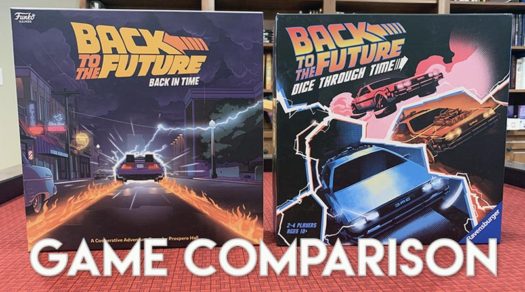
One Movie vs. All Three Movies
The first noticeable difference is that DTT covers all 3 movies and has players jumping around in time from year to year. Whereas, BIT covers just the events of the first movie and doesn’t include any time-travel elements during the game.
The objective in BIT is to get George and Lorraine to fall in love in 1955 while also getting the DeLorean in position before lightning strikes the Clock Tower at 10:04 pm. Players move around Hill Valley, overcoming Trouble, and using Power tokens to roll dice and take actions (like fighting Biff, moving the DeLorean, or getting George and Lorraine more in love).
The objective in DTT is to find lost Items across time and get them back to their correct year and location. In order to find the Items, players must keep Biff out of the way and overcome the Events that pop up all over the place (and years).
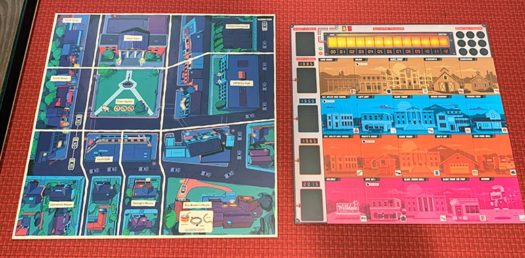
One thing we’ve found interesting is that even though DTT brings in elements from all 3 movies, it doesn’t pull us into the theme as much as BIT does. Perhaps it’s because by focusing on just one movie, it can get more immersed in the elements from that movie. The Opportunity cards that come out in BIT are very specific such as meeting uncle Joey, borrowing George’s binoculars, or being called out as a slacker by Stickland.
We also found that even though DTT covered 3 movies and there’s plenty of material to pull from, we often have the same named Event card show up in the same location. For example, having 3 Hoverboard Chase cards on the Clock Tower Space at one time. They’re the same named event but just require different dice results to resolve. We find ourselves wishing for more variety in the DTT Event cards.
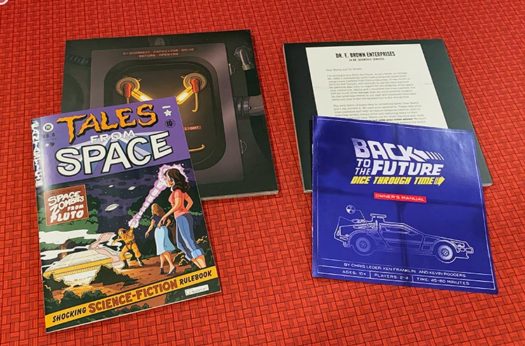
Cars vs. Characters
The next most-noticeable difference is that in DTT each player has a DeLorean to move around the board while players in BIT are characters in the movie – Marty, Jennifer, Doc, and Einstein.
Obviously, you need a DeLorean if you’re going to be traveling back and forth through the various years (rows on the board). But unfortunately, being a car isn’t as engaging to us as being characters in the movie.
In BIT, we get to be someone walking around Hill Valley and facing different challenges that come along. It’s much easier for us to connect with.
And having characters to interact with makes getting George and Lorraine to fall in love a great thematic element.
Plus, with characters it’s more natural to grant them each special abilities!
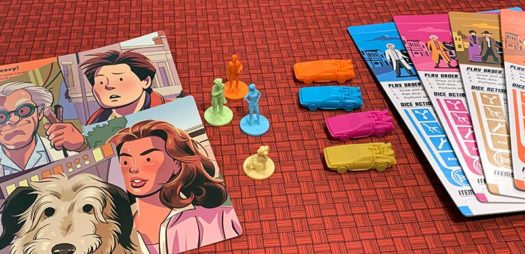
Special Abilities
How important are special abilities?
Just imagine what The Avengers would be like if they all had the same abilities. I highly doubt the movies would be blockbusters.
And that same concept holds true in cooperative board games. Yes, we’re all working together, but it’s also fun to have an ability that no one else has.
In BIT, Marty can move Lorraine closer to him, Jennifer can move Marty, Doc, or Einstein closer to her, Doc can move directly to the DeLorean space without using a die, and Einstein can move Biff around. Using special abilities at the right time adds both flavor and fun to the game.
Unfortunately, special player abilities are absent in DTT. And even though each player’s dice matches their DeLorean color, the probabilities on all the dice are exactly the same.

Roll Simultaneously vs. Roll on Your Turn
Both games include lots of dice rolling. However, the way it occurs is vastly different.
In BIT, players begin with 5 Power Tokens and can gain more throughout the game. These Power Token indicate which dice the player can roll on their turn. And they can choose when to roll which dice for different challenges. Each challenge requires a dice roll and players have to deal with the results in that moment.
That means BIT is filled with in-turn, risky dice rolls. It’s not just a paint-by-numbers turn. Each player makes their own choices on which challenges to face, then rolls the dice to see if they’re successful. You can’t plan out the perfect turns and luck will have its say.
In DTT, all players simultaneously roll their dice at the start of each round. Once rolled, players can discuss what they’ll be able to do on their turns. Then, in turn order, players take their turns and spend their dice to do different actions. Most of those actions will be carrying out what they discussed at the start of the round.
While the way dice work in DTT means you can do advanced cooperative planning, to us it also makes the game feel programatic. You make your plans at the outset, then carry them out in turn order.
So depending on where you like your luck to fall, you may be drawn to one game over the other. If you like to see your lucky results as a group and then make plans, you’ll tend to prefer DTT. If you like to make some choices and then see how lucky you are with your rolls and deal with the outcome, BIT will be more for you.
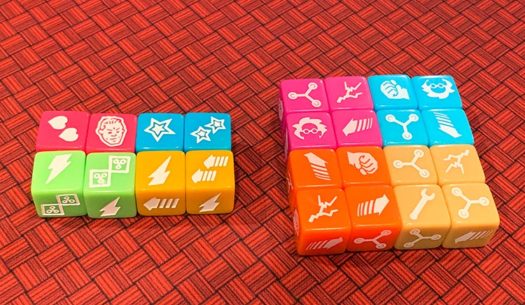
Biff – Nuisance or Menace
We all know Biff is a force to be reckoned with. Not necessarily an intelligent one, but a force nonetheless.
In DTT, there are 4 Biffs to face – one in each year players pass through. Whereas in BIT, there’s just 1 Biff to deal with.

You might think 4 is tougher than 1.
But in our experience, 1 is a Menace whereas 4 are a Nuisance.
While playing DTT, when you draw an Event card with a Biff icon on it, you move the Biff in that year to that location. Players must deal with Biff before they can resolve Events and find or return items in that location. Yes, it will take a die with a Fist result to move Biff away before you can resolve the cards. But it feels kind of like swatting away a fly that’s annoying you.
In BIT however, Biff can considerably disrupt your plans.
On a player’s turn, they start by drawing a Movement card which will move George, Lorraine, or Biff – or various combination of them. Biff is on plenty of movement cards (as well as on the dice rolls) and always goes straight for George or Lorraine. While he shares spaces with them, the Love Meter is very likely to suffer.
Players must constantly be dealing with Biff – fighting him off to keep him away from the love birds.
Thus, he isn’t a mere nuisance, he’s truly a menace!
So which game you’ll prefer may depend on how much you like the villains messing with your plans.
Outset Difficulty vs. Increasing Difficulty
Another thing we really like in our cooperative games is a growing sense of dread. We want to feel more challenged as the game progresses.
Of course, we also love it when we’re able to ramp up our abilities to face those challenges.
In DTT, at the outset, players choose the level of difficulty they want to face. What controls the difficulty level is how many Items players must find and return in order to win the game. Increasing the difficulty this way essentially makes the game last longer. And the longer the game lasts, the more Event cards and Paradox tokens will show up on the board – which in turn will increase the likelihood of the OUTATIME marker hitting the Game Over space and the players losing the game.
In BIT, the Trouble cards are what change the difficulty over the course of the game. There are 3 different levels of Trouble cards. The first Trouble cards that are drawn will be from level 1. Mid-game, they’ll be from level 2. And the latter portion of the game will be from level 3. Thus, the challenges players face will be harder later in the game. In addition, Love Meter checks will double near the end of the game – making it more likely the family portrait will disappear, and players lose the game.
The big difference between the games is that in BIT, the players will have more capabilities at their disposal to overcome such challenges. Players feel a sense of progression as they complete Opportunity cards and gain more dice and special items to get bonus actions. So by the end of the game, they have more they can do on their turns.
For us, we enjoy the increasing threats in BIT as well as the additional Items that let us do more without extending the game play time itself.

Our Final Take
If you haven’t guessed by now, we’ve enjoyed playing Back to the Future: Back in Time more than Back to the Future: Dice Through Time.
Both games have clever game mechanics, are great at getting players to work together, and tie well to the theme. But in the end, Back to the Future: Back in Time draws us in and engages us more. Plus, the Back in Time games we’ve played have varied more widely than our plays of Back to the Future: Dice Through Time.
The randomness of dice rolls during challenges keeps us adjusting our plans along the way. And because of that variety, we anticipate more repeat plays of Back to the Future: Back in Time in our future.






Thanks Trent for a fantastic comparison. I have a lot of nostalgia for the films and was super intrigued by the newly released board games. I really appreciate your in depth reviews as well as this side-by-side comparison. You rock man! 🙂
Glad to hear it helped Chris!